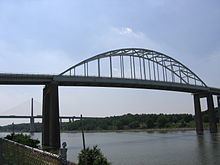Locale St. Georges, Delaware Opened 1942 Total length 1,283 m | Design Tied arch bridge Clearance below 41 m Location Saint Georges, Delaware | |
 | ||
Carries US 13(2 traffic lanes, 2 bike lanes) Crosses Chesapeake & Delaware Canal Maintained by U.S. Army Corps of Engineers Width approx. 28 feet (8.5 m) Body of water Chesapeake & Delaware Canal Bridge type Arch bridge, Tied-arch bridge Similar Reedy Point Bridge, Ship John Shoal Light, Chesapeake & Delaware, Chesapeake & Delaware, Harbor of Refuge Light | ||
The St. Georges Bridge is a steel truss bridge with a tied arch span that carries U.S. Route 13 (US 13) across the Chesapeake & Delaware Canal in St. Georges, Delaware. Built by the U.S. Army Corps of Engineers and opened in 1942 as a high-level crossing, the bridge was the first four-lane, high-level crossing to span the canal. It replaced a previous vertical lift bridge which was damaged when a German merchant ship collided with it.
Contents
History and near replacement
On January 10, 1939, the S.S. Waukegan struck and destroyed the original St. Georges Bridge, killing the bridge tender. The replacement steel truss St. Georges Bridge over the canal opened on January 31, 1942. This bridge was the first four-lane crossing of the Chesapeake and Delaware Canal.
Prior to the opening of the paralleling Delaware Route 1 Turnpike and the Chesapeake and Delaware Canal Bridge in 1995 (renamed the Senator William V. Roth, Jr., Bridge), the bridge was the main north–south crossing in Delaware, as such, suffered from a deteriorating concrete deck and support beams that forced both the Delaware Department of Transportation (DelDOT) and the Army Corps of Engineers to place a weight restriction and forced all through truck traffic onto the paralleling Summit Bridge (U.S. Route 301), seven miles (11 km) to the west. The late U.S. Senator Bill Roth, who saw the need for a new crossing, was a main proponent in securing federal funding for the new C&D Canal Bridge.
After the opening of the paralleling C&D Canal Bridge, the Army Corps of Engineers closed the St. Georges Bridge in anticipation of demolishing the structure. Local opposition arose, especially from residents in St. Georges, whose town spans both sides of the canal; these residents would have had to travel out of their way and pay an additional toll to go from one half of the town to the other. Instead of tearing down the bridge, the Army Corps of Engineers, using data issued from the Delaware Department of Transportation and the U.S. Census Bureau, rehabilitated the bridge between 1998 and 2001. A new concrete deck was constructed, and deteriorated beams and joints were replaced. The lead-based paint on the bridge was removed and replaced with a lead-free primer and salt-resistant enamel (the C&D Canal connects two rias, having from time to time been inundated with brackish water during dry spells), and the bridge was reopened to local traffic. As a result of the need to maintain quick access to both U.S. 13 and the Del. Rt. 1 Turnpike, both the St. Georges Bridge and the C&D Canal Bridge have no tolls (the Army Corps of Engineers allowed DelDOT to build a South St. Georges interchange to U.S. 13 between the bridge and the Biddles Corner toll facility, with provisions to build another exit north of the bridge if needed). Prior to the mid‑1990s, the St. Georges Bridge also served as the crossing for U.S. Route 301, but this has since been shifted to the Summit Bridge along with Delaware Routes 71 and 896.
Current Restrictions
The U.S. Army Corps of Engineers announced that beginning Tuesday, May 27, 2008, both outside lanes across the St. Georges Bridge will be closed, limiting traffic to one lane in each direction. Also, traffic will be restricted to vehicles weighing less than 15 tons. Lane restrictions will remain in place as an extra safety measure until repairs can be made to the bridge's substructure and bearings, tentatively by the end of the calendar year. Repairs under the outside lanes will be done first. Once those are complete, the weight restriction will be lifted, the outside lanes will be reopened, and the inside lanes will be closed instead. After all repairs are completed, the bridge will be fully reopened. During a recent inspection, the Corps identified concrete surface cracks and rebar corrosion in numerous bridge piers, along with numerous highly corroded and failing bearings under the bridge deck. None of this represents an immediate danger to the public; the overall bridge structure remains sound. However, these deteriorated conditions have reduced the margin of safety. Lane and weight restrictions address this problem by limiting the load on the bridge, thus allowing time for the Corps to institute daily monitoring, conduct further analysis, and make the appropriate repairs to safely return the bridge to full operation.
In May 2010, conversion of the outside lanes to bike lanes was completed.
